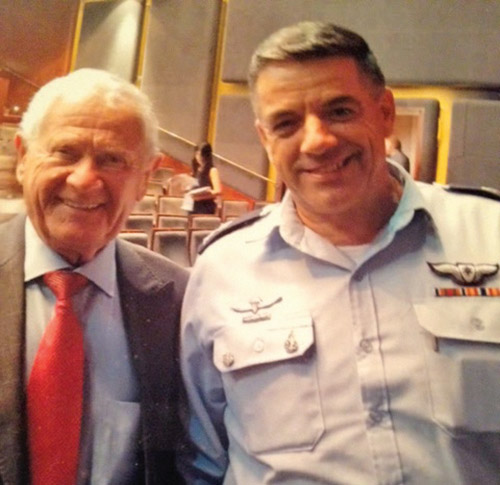



Barry Bichler’s extraordinary artistic talents were apparent at a very young age. As his father, Abraham Bichler of Fair Lawn, explained, “He made model airplanes at the age of 4 or 5, and, while in second grade at Yavneh, built a model of the 1969 lunar module out of paper. His teacher was so amazed that she brought him and his creation into every classroom from first grade through eighth.”
In fact, Barry Bichler was always enthralled with anything related to aviation. By his father’s account, he amassed a collection of over 600 books related to the topic, took his first flying lesson, at Teterboro Airport, at the age of 14, and skydived upwards of 2000 times, winning numerous medals for his efforts. But what Bichler is most famous for is his incredibly detailed paintings of airplanes and air battles. They have appeared at both the Paris and London air shows, and won him a prize at the Smithsonian Air & Space Museum in Washington, DC.
It was at the 1980s Paris Air Show that Israeli officials first took notice of Bichler’s work and invited him to Israel to discuss his artistry. The IDF commissioned him to create five paintings, and were so impressed with the quality of his work that they asked him to put together a full array of illustrations depicting the history of the Israeli Air Force. He spent a year on the project, but because of a budget snafu, the air force was not able to make good on their offer and the pictures remained with Bichler.
The elder Bichler took The Jewish Link through his home for a tour of his son’s works and awards. The intricate details of each plane were striking. They appeared more like photographs than original works of art. He noted that Israeli officials who had seen these works were able to immediately identify the specific occasion or battle a particular painting had depicted because of that realism.
It was a bittersweet recollection since Barry Bichler was not there to explain the works for himself. He contracted diabetes at a young age, and not many years ago it progressed to the point where he was in need of a kidney transplant to survive. Although the transplant was a complete success, less than a year later, in 2016, he suffered a pulmonary embolism and died suddenly. Abraham explained that as he surveyed the works about a year-and-a-half ago, he knew he could never sell them. Instead, he decided to donate the entire collection chronicling the history of the Israeli Air Force to those in Israel who would most appreciate it.
“My son had been an ardent Zionist since his teen years when the family would take summer trips to Israel,” he offered. “This should be the place for his collection, which numbers about 25 paintings, to rest.”
Abraham himself has a storied history. As a Holocaust survivor who as a child was shipped with his family to Stalin’s labor camps in Siberia, he arrived in the U.S. at age 16. He went on to receive his doctorate and taught Hebrew studies and history in the public school system as well as at Fairleigh Dickinson University. He has addressed numerous audiences, including many synagogues and schools, on the horrors his family faced under Stalin’s Russia, and is the author of a book, “Little Miracles,” which chronicles his years in Siberia and his family’s ability to reach within for the hope and faith needed to survive.
Abraham recalled his recent trip to Israel as a guest of the Israeli government following his announced intentions to donate his son’s paintings. Because of a five-hour flight delay, he missed a planned air force base tour, but instead was later treated to a two-hour private tour of a base near the Syrian border. He proudly spoke of meeting the base commander of the Israeli Air Force. “Who would have believed it?” he exclaimed. He spoke of how friendly and down to earth the generals he met were, and some of the amazing things he saw, some of which he’s not at liberty to discuss.
The highlight of his visit was his attendance as a guest of the Israeli Air Force to a ceremony held at the Opera House in Tel Aviv. The annual invitation-only event includes 1000 attendees. He noted that he was seated in the second row behind a group of generals. He spoke of the pomp and circumstance as drum rolls welcomed VIPs into the hall, and huge shofars were blown at the arrival of various generals. A significant portion of this year’s program was in honor of his son and his paintings. Abraham described the scene. “A huge screen was lowered and began to revolve, projecting the name of my son and five or six of his air force paintings.”
He later spoke of one particular painting, which depicted “The Lavi,” a plane that was state-of-the-art when it first came onto the scene. The designer, who was now head of the Israel Aerospace Industries, wanted that painting to hang in his office. Abraham said he’d gladly give it to him, but in return wanted an award in the name of Barry Bichler to be given annually to an outstanding, deserving student.
Above all, Abraham wanted each of his son’s paintings to rest in a location where people who appreciate the contributions of the Israeli Air Force could enjoy them for years to come. “My son knew nearly every detail about the history of the Israeli Air Force. He lived it as he painted it. There was no more fitting place for his memory to be honored.”
Robert Isler is a freelance writer who lives in Fair Lawn. He can be reached at [email protected].













